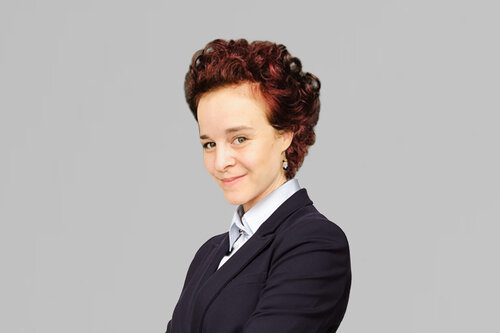
5 Questions with Julie Martin, Economic Development Specialist, Montgomery County Economic Development Corporation
“5 Questions With…” is a weekly BioBuzz series where we reach out to interesting people in the BioHealth Capital Region to share a little about themselves, their work, and maybe something completely unrelated. This week we welcome Julie Martin, Economic Development Specialist, Montgomery County Economic Development Corporation (MCEDC).
Julie Martin is a South African born Australian with 20 years commercial facing experience across government, private industry and the not-for-profit sectors. Julie develops investment attraction opportunities for the Montgomery County Economic Development Corporation in the state of Maryland, USA and holds a Master’s Degree in International Development from the Royal Melbourne Institute of Technology in Australia.
Her background has included trade and investment, industry and workforce development, economic strategy, regulatory reform, and innovation economics. Her research interests include development theory and job creation and her work experience has gravitated towards biotechnology, frontier tech sectors and social science.
1. Please introduce yourself to our audience with a look back at your education, training, and career.
I moved from Australia to the USA at the best possible time: January 2020. The last iteration of my career before moving to the USA was spent working for the largest state economy in Australia, New South Wales (think Sydney), where I developed the life science and frontier technology industry sectors for the state government. I spent the first 28 years of my life in South Africa, experiencing its difficult and racially fraught transition to a post-apartheid society. I then spent the next 13 years living in and working for one of the best functioning socialist-democracies in the world, and so I can’t help but bring an unusual and perhaps provocative perspective to economic problems.
I moved to the USA, because I wanted my bi-racial child to live in a society where she could see her reflection, and because I knew about the unique assets located in this region. There is an opportunity in the DMV, and it made professional and personal sense to undertake the adventure. I also believed my lived experiences, academic training, and professional perspectives would be helpful in tackling some of the more difficult economic and social challenges I observed during my travels to various parts of the USA over the last decade. I enjoy defining and evaluating tough economic problems and developing resilient and equitable economies that meet unprecedented times
2. Go a little more in-depth in your role with MCEDC, specifically as it relates to biotech?
My role with the MCEDC is investment attraction-centric. I primarily identify mid-to-late-stage cell and gene, immunology, and biomanufacturing companies internationally and domestically to develop a project pipeline of business attraction prospects. I leverage our County and State incentive programs, regional assets, and value proposition to increase the number of new, quality jobs coming into Montgomery County.
I help companies identify the best route to accelerate their speed to market by introducing and assembling the teams needed to help them win. For example, we help guide companies looking to tap into non-dilutive funding and help them build the strategic relationships they need to gain a strong foothold in the U.S. An excellent example of this is curating technology transfer opportunities with our Federal Laboratories and identifying in/out-licensing opportunities that match our life science company products and services.
My team works together to manage retention and expansion projects for our local companies and site selection consultants, including helping companies access expedited permitting, talent, and the resources they need to remain agile and thrive here. Occasionally, I identify potential Foreign Direct Investment funding sources from public actors that could benefit the County and State.
3. As Montgomery County is geographically the center of the BioHealth Capital Region, how do you grow the brand, county, and region?
In the past, Montgomery County, Maryland, has felt like the genius youngest child whose softly-spoken voice gets drowned out by the din at chaotic family gatherings. Our noisy older siblings in Boston, New York, and San Francisco get all the attention at the expense of our prodigy and the sector. I believe this narrative is rapidly changing and with due cause. Compare our rents to the top three; we are nearly half what those rents are in Boston, New York, and San Francisco, and we have the largest number of federal laboratories compared to any other state in the USA.
In 2020 alone, close to $8 Billion in federal, private, and foundational funding was invested in life sciences companies with a Montgomery County presence for coronavirus vaccine research and other immunotherapeutic developments. We are the global ‘Immunology Capital next to the Nation’s Capital’ and one of the smartest destinations from which an international company can grow in the USA. My goal is to continue amplifying the compelling business case for locating here through outreach, conferences, and facilitating mutually beneficial trade relationships and technology transfer.
I moved to the USA and joined the MCEDC two months before the pandemic hit, so getting this message out on the international stage has been challenging in a 100% virtual environment. Despite the obstacles, my team has worked hard over the past year to refine our value proposition and make meaningful virtual connections with international and U.S. companies that can benefit from doing business and locating here.
The pandemic put the spotlight on our county and our world-class scientific community, which has supercharged the industry demand for space. During the pandemic, I led the inaugural international and virtual component of the Maryland Life Science Bio Innovation Conference in 2020, which the MCEDC sponsored. We solicited more than 100 international delegates to the 2020 event from Australia, Japan, Korea, Taiwan, Canada, the U.K., and other parts of Europe. For the upcoming 2021 event, I worked with the Federal Lab Consortium and our MCEDC team to design a guide on how to undertake technology transfer in Maryland to better assist early to mid-stage companies looking to gain a strategic foothold in Maryland. Our county has definitely become more sophisticated at telling our story.
4. Post-Pandemic, what is MCEDC working on for the 2nd half of 2021 and beyond?
Our areas of focus moving forward include: advancing Montgomery County industry growth and sector diversification; fostering the county’s entrepreneurial activity and new business formation; and responding to the needs of targeted and emerging industries. For example, we plan to expand our federal engagement strategy and partnerships with federal laboratories, federal funding programs, regulatory agencies, and technology that can be commercialized. You’ll be glad to hear that two of our targeted industry areas are life sciences and quantum!
We also plan to facilitate greater access to capital for emerging and growth businesses by creating an MCEDC Capital Network of funding sources targeted for Montgomery County businesses. The aim is to better support an inclusive economy by working with partners to identify and source funding directed to and received by a more diverse group of entrepreneurs. We will also be developing comprehensive marketing programs for all three of these focus areas to better position the county for business attraction and retention purposes.
5. If You Could Learn Any One Skill In The World Without Trying, Which Would You Pick and why?
I’d learn how to build a 300 qubit quantum computer. I believe quantum technology will transform the way we undertake scientific discovery. IBM and Google have already built small, 50 or 60 quantum bit computers, and we’re told 300 bits will be able to process more pieces of information than the number of particles in the universe. We are in the throes of the 4th industrial revolution — what was impossible rapidly becomes possible.
Artificial intelligence is already here in our cancer screening clinics, protecting our environment, identifying new therapies and vaccines, and speeding up our biomanufacturing processes. It’s in our mobile phones, traffic lights, and elevators, and it’s helping companies make more intelligent decisions at a much more rapid pace.
We are all familiar with the lengthy process typically involved in the trial of new medicines and the fact that 90% of starters don’t make it to the finish line. Even for those that are successful, the process of lab to market takes an average of 12 years. Frontier technologies like quantum are reducing this time dramatically and are beginning to unlock opportunities in protein folding and molecular dynamic modeling, for example.
One of the drugs used to treat COVID-19 was discovered and then modeled using a deep learning algorithm. Once it stacked up virtually, this coronavirus therapy was able to go straight into trials and then to market in a matter of months. Suppose we are going to avoid locking in a two-dimensional economy. In that case, it is my personal view that we need to attract the entrepreneurs running these early-stage companies with the expertise to design, develop and operate these future technologies.
We need to start immediately, not 5 years from now. The international race to dominate the intersection between quantum-in-bio is on. Montgomery County is uniquely positioned to do well at this intersection and has a window of opportunity to gain a strategic advantage.
Thank you to Julie Martin, Economic Development Specialist, Montgomery County Economic Development Corporation (MCEDC), for participating in the 5 Questions with BioBuzz’ series, and stay tuned for more interviews with others from across the BioHealth Capital Region and beyond.






